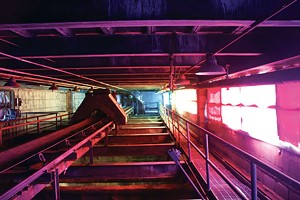Published September 11, 2013 at 7:24 a.m.
From the outside, Burlington’s Moran Plant is a hulking eyesore, a fenced-off, industrial brick behemoth plunked on the Lake Champlain waterfront like an oversize step stool. Inside — as I learned on a recent tour with Community and Economic Development Office director Peter Owens and Burlington painter Katharine Montstream — it’s a grand cathedral of decay.
I had to sign a waiver to go in. The concrete floors are pockmarked with holes; it would be easy to break a leg. I had been warned about the raccoons. Humans left the derelict power plant when it was decommissioned in 1986, but the critters have made a home there. As Owens wrangled the padlock on the plant’s basement door at the start of our tour, Montstream quipped, “The raccoons changed the locks.”
We stepped onto a catwalk-type mezzanine in the dark, disorienting basement. Below us, several feet of water covered the floor, making it difficult to tell where metal staircases began and ended. There were holes in the walls, archways leading to more archways and eerie, half-submerged pillars.
“When you frame it with a camera, it’s an abstractionist’s dream everywhere you look,” remarked Owens.
It’s no wonder the Moran Plant has become a source of inspiration to Burlington artists. In a state practically drowning in bucolic landscapes, Moran’s urban decay is electrifying. Over the past several months, at least two local artists have used it as a muse: Montstream and Sarah O Donnell.
Montstream, whose paintings of the Moran interior are currently on view at Montstream Studio in downtown Burlington, first got inside the plant last February at a city-organized “Popup Moran” event designed to spark interest in the future of that neglected slice of waterfront.
Moran has been languishing for years. At one time, Owens said, there were plans to turn the space into a children’s museum. Just last year, the mayor shot down a proposal to build ice-climbing walls inside. Arts organizations such as the Fleming Museum and Burlington City Arts have long considered using the plant. Nothing has ever panned out.
At the February event, Montstream recalled during our tour, a garage door on the back of Moran was rolled up to allow a peek inside the cavernous space, which was illuminated by a temporary light display. The beams cast mesmerizing shadows on the plant’s gaping interior. “It was astonishing,” she said.
Montstream approached Owens about arranging a full tour of the building. He was eager to start a dialogue about the plant’s possibilities and agreed to take her and a few friends inside.
They went in at night, Montstream armed with a ski pole to fend off raccoons. But the artist fell in love instantly. “It was this intensity of scale and shape that affected me on this visceral level,” she said. “I went in there to brainstorm, but I came out and just thought, I have to have a show about this.”
After 25 years of painting serene Vermont landscapes and reproducing them as prints and cards through her business, Montstream Studio, the artist had been itching for a change. “I can take a risk now,” she says. “I feel comfortable doing something that probably won’t be popular with tourists.”
Maybe not, but locals familiar with the plant are likely to be drawn to these paintings. Moran may be all chipped paint and concrete floors, but Montstream’s images pulsate with color and life.
Peter Owens said he’s interested in “changing the script of failure and abandonment” about Moran. After all, before it was decommissioned, the plant was viewed as cutting-edge technology. “The design itself as an industrial structure was seen as quite forward-looking,” Owens said. “It became an experimental prototype for wood-chip burning.”
After the tour, I tracked down Tom Carr, who was the plant’s superintendent from 1968 to its decommissioning. “I’m the last survivor,” said the 80-year-old.
When the plant was in operation, he recalled, “It was well kept up and relatively clean for a coal-burning facility.”
In 1977 Carr was involved in shifting the plant to burning wood chips. “We realized that the life of the Moran station was coming to an end for a variety of reasons, most of which were financial,” he said. Burlington Electric Department couldn’t afford to upgrade the plant to comply with more rigorous environmental standards, so its leaders planned a new facility, the McNeil Generating Station. But before ditching Moran, they’d use it as the prototype for a new generation method.
Nuclear energy was out of the question. Natural gas was viable, but only in the summer. And coal had become too expensive — plus, the residents downwind wanted relief. BE even considered burning garbage, to no avail.
“So we sat around and scratched our heads,” Carr recalled. “And in a blinding flash, we decided that there’s enough trees in the state; maybe we could burn wood.”
BED discovered it could take advantage of Vermont’s forests and landowners, who were paying $25 an acre at the time to thin their forests to improve tree quality.
Carr traveled the country picking up tips at wood-chip-burning power plants and paper mills. Then he and his Moran colleagues jerry-rigged a system for unloading wood chips and hacked together a technique for blowing chips into the boilers.
“It was a great place to work. It really was,” Carr said.
He hasn’t been inside Moran for at least 15 years and was shocked the last time he walked through. “It was a total vandalized wreck,” he said.
As for the future, Carr said he’d love to see Moran transformed into something “useful for the community,” but he’s skeptical about the cost, especially when it comes to reinforcing the aging infrastructure. “Over time, I think the building may have deteriorated substantially,” he said, and noted that the water in the basement has been freezing and thawing since 1986, a cycle that “cannot be doing good things to the foundation.”
If you ignore the creepy raccoon paw prints and the water that glows a nuclear-waste-style green when the sun catches it, it’s easy to imagine future uses for Moran. During our tour, Montstream and Owens rattled off their favorite ideas: an indoor farmers market, a skating rink, a maker space, a hall for wedding receptions.
“My first idea was that this would be a bathhouse, like in Budapest,” Montstream said.
Owens envisions the Great Hall space as a performing-arts venue with an enormous picture window overlooking the lake and Adirondacks. He’s already picked out his first two fantasy shows: a solo cellist performing the Brandenburg Concertos under a single spotlight; and a dramatic reading of Dylan Thomas’ “Do Not Go Gentle Into That Good Night” by Sen. Bernie Sanders.
More community ideas have been percolating since the city put out a request for proposals earlier this year. One of those plans, from a dynamic team made up of two University of Vermont students, Tad Cooke and Erik Crockenberg, and home designer and real estate investor Charlie Tipper, aims to transform Moran into a “publicly accessible, financially sustainable, city-owned and nonprofit-managed” community center. The team hopes to keep what’s good about Moran — its vast interior spaces and great views — and upgrade the rest to showcase local arts and food and create more opportunities for waterfront recreation.
Sounds great. But after 30-plus years of stagnation, why should we believe the Moran Plant might be revived this time?
“I think a lot of things have aligned,” Tipper told me later. “And to take [the building] down is arguably more expensive.”
Mayor Miro Weinberger has been excited about the surge of interest in the Moran. He said he’s “cautiously hopeful” that this time the plant might actually get a second life. “When you step inside, see those soaring spaces, see that view of Burlington that’s unlike any other view – I’ve always been excited about repurposing that.”
But the mayor has his doubts, too. “I think this is a very difficult development challenge, and I don’t know if we will succeed,” he went on. “I really think this is the last, best hope for the building. If we don’t succeed, we have to seriously consider tearing it down.”
We climbed several more staircases to the very top floor, which required walking across a narrow catwalk beside a conveyor belt. We stood above the mouths of the hoppers that once swallowed coal and wood chips.
This room has a different vibe now, thanks to Burlington artist Sarah O Donnell and her installation “A Visible Night.” At night, a swiveling light rigged above the hoppers illuminates a rainbow of silk panels hung in the glassless windows. During the day, sunlight streams in through the silk, making the place feel like a nightclub.
O Donnell said she was struck by how visible the building is in the Burlington landscape, yet how removed it feels inside. “Whenever I was inside it felt like I was incredibly separate from the city,” she wrote. “I could hear so much of what was going on outside — children playing, skaters using the skatepark behind it, the sailing center’s summer camps were going on around us, but even though I was in a building that sits right in the middle of so much activity, I felt incredibly isolated and removed.”
Our tour wasn’t over yet. Owens, Montstream and I climbed a steep ladder and popped through a hatch onto the roof. Clumps of goldenrod swayed in the breeze. It was like standing on a sky-high pier jutting over the lake. No question, it’s the best view in Burlington.
We took a seat and talked about feasibility. “The finances are difficult,” Owens admitted. “There’s certainly opportunity for revenue, but we haven’t come up with a cash stream yet.”
For now, Owens, Montstream and other Moran enthusiasts are taking a new tack: Instead of clinging to grand visions, they’re focusing on identifying the minimum improvements necessary to transform the plant into a “functional ruin.” That’s one way to get people in the door and start their imaginations cranking.
It’s a smart tactic, considering that everyone who sets foot in the plant seems to fall under its spell. “I think I’ve fallen in love with this space in its worst state,” Montstream said later, surrounded by the paintings and sketches of Moran she has created over the past seven months. “And now I’m in love with the dream of what it could be.”
The original print version of this article was headlined "Beautiful Ruin."
More By This Author
Speaking of Senator, Bernie Sanders
-

Vermont Awarded $62 Million in Federal Solar Incentives
Apr 22, 2024 -

Man Charged With Arson at Bernie Sanders' Burlington Office
Apr 7, 2024 -

Police Search for Man Who Set Fire at Sen. Bernie Sanders' Burlington Office
Apr 5, 2024 -

Bernie Sanders Sits Down With 'Seven Days' to Talk About Aging Vermont
Apr 3, 2024 -

Sociologist and Author Nikhil Goyal Talks Education, Books and Bernie
Dec 6, 2023 - More »
Comments
Comments are closed.
From 2014-2020, Seven Days allowed readers to comment on all stories posted on our website. While we've appreciated the suggestions and insights, right now Seven Days is prioritizing our core mission — producing high-quality, responsible local journalism — over moderating online debates between readers.
To criticize, correct or praise our reporting, please send us a letter to the editor or send us a tip. We’ll check it out and report the results.
Online comments may return when we have better tech tools for managing them. Thanks for reading.




















































